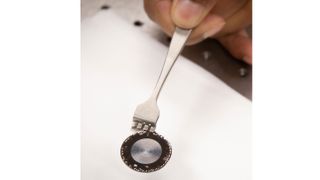Whether you’re an iPhone user, Huawei super-fan, Samsung phone devotee or OnePlus worshipper, everyone can agree that camera bumps – protrusions in a phone's casing, where the camera is housed – are annoying. They get damaged easily, stop you lying your phone flat on a table, and feel irritating when you’re holding your phone in landscape. However, a solution is in hand.
This solution comes from the University of Utah, in Salt Lake City, where a group of researchers have just invented smartphone camera lenses that are just a few micrometers thick. If you don’t know what a micrometer is, maybe this will give you an idea: it’s a millionth of a meter, meaning these lenses are thousands of times thinner than those currently in use in flagship smartphones – and twenty times thinner than a human hair.
This news was published in a scientific paper titled "Broadband lightweight flat lenses for long-wave infrared imaging", which describes a truly tiny optical lens. It can fulfill all the functions of a thicker smartphone lens by effectively creating numerous tiny structures that bounce light to the sensor, working together to act as a lens.
A super-thin smartphone lens sounds great, but how will this actually transform your camera experience? We spoke to Rajesh Menon, an electrical and computer engineering associate professor at the University of Utah, to better understand these little lenses.

(Image credit: TechRadar)
Understanding super-thin smartphone lenses
The University of Utah researchers’ prototype lens was flat, but most smartphone lenses are rounded – the ‘main’ camera on a phone is usually a wide-angle lens. Naturally, then, our first question was about lenses.
Specifically, we asked Menon if these micrometer lenses would come in different specifications – such as ultra-wide angle, telephoto, macro, or more. The answer was simple enough: “Yes, this is exactly what we do."
“The idea is to make this completely transparent to a lens designer. In other words, the lens designer will specify [what they want] and our algorithms will turn those specifications into flat lens designs." So it’s very possible that these lenses will come in all the configurations you see on the back of your smartphone already.

(Image credit: Dan Hixson / University of Utah )
The tech is great, but as is often the case with scientific breakthroughs like this, it’s possible that it could still be a ways off arriving in retail – so our next question was whether we could see this in smartphones any time soon, and what kind of time scale this would be.
“My best guess is 2-3 years,” Menon told us, adding that, “Before smartphones, there are applications in aerospace and UAVs, where these lenses will be applied.”
When news of the research broke, several other uses for the lenses were touted alongside smartphones, such as lighter military drones, or night vision equipment, mainly for military use – and it’s possible the lenses will be deployed for those purposes before making their way to smartphones.
It’s very easy to drop a smartphone and have it break, and this risk is increased significantly if the lens in use is a twentieth the thickness of a human hair, so our final question was about the frailty of this lens. According to Menon, though, there’s nothing to worry about: “All lenses today are protected behind strong glass, so this can be the same for our lenses as well.”
In short, you’d have to severely damage your phone for the lenses to be affected.
https://www.techradar.com/news/the-best-phone-camera-lenses-could-be-about-to-get-dramatically-thinner
2019-10-20 10:00:00Z
CBMiZmh0dHBzOi8vd3d3LnRlY2hyYWRhci5jb20vbmV3cy90aGUtYmVzdC1waG9uZS1jYW1lcmEtbGVuc2VzLWNvdWxkLWJlLWFib3V0LXRvLWdldC1kcmFtYXRpY2FsbHktdGhpbm5lctIBamh0dHBzOi8vd3d3LnRlY2hyYWRhci5jb20vYW1wL25ld3MvdGhlLWJlc3QtcGhvbmUtY2FtZXJhLWxlbnNlcy1jb3VsZC1iZS1hYm91dC10by1nZXQtZHJhbWF0aWNhbGx5LXRoaW5uZXI
Bagikan Berita Ini














0 Response to "The best phone camera lenses could be about to get dramatically thinner - TechRadar India"
Post a Comment